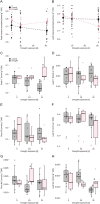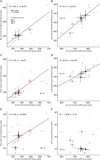Date palm diverts organic solutes for root osmotic adjustment and protects leaves from oxidative damage in early drought acclimation
- PMID: 39521950
- PMCID: PMC11850976
- DOI: 10.1093/jxb/erae456
Date palm diverts organic solutes for root osmotic adjustment and protects leaves from oxidative damage in early drought acclimation
Abstract
Date palm (Phoenix dactylifera L.) is an important crop in arid regions and it is well adapted to desert ecosystems. To understand its remarkable ability to grow and yield in water-limited environments, we conducted experiments in which water was withheld for up to 4 weeks. In response to drought, root, rather than leaf, osmotic strength increased, with organic solutes such as sugars and amino acids contributing more to the osmolyte increase than minerals. Consistently, carbon and amino acid metabolism was acclimated toward biosynthesis at both the transcriptional and translational levels. In leaves, a remodeling of membrane systems was observed, suggesting changes in thylakoid lipid composition which, together with the restructuring of the photosynthetic apparatus, indicated an acclimation preventing oxidative damage. Thus, xerophilic date palm avoids oxidative damage under drought by combined prevention and rapid detoxification of oxygen radicals. Although minerals were expected to serve as cheap key osmotics, date palm also relies on organic osmolytes for osmotic adjustment in the roots during early drought acclimation. The diversion of these resources away from growth is consistent with the date palm strategy of generally slow growth in harsh environments and clearly indicates a trade-off between growth and stress-related physiological responses.
Keywords: Phoenix dactylifera L; Antioxidant; halophyte; lipid metabolism; membrane remodeling; osmolyte; oxidative stress; reactive oxygen species; water deficit.
© The Author(s) 2024. Published by Oxford University Press on behalf of the Society for Experimental Biology.
Conflict of interest statement
The authors declare that they have no known competing financial interests or personal relationships that could have appeared to influence the work reported in this paper.
Figures









References
-
- Ali U, Li H, Wang X, Guo L.. 2018. Emerging roles of sphingolipid signaling in plant response to biotic and abiotic stresses. Molecular Plant 11, 1328–1343. - PubMed
-
- Ali-Dinar H, Munir M, Mohammed M.. 2023. Drought-tolerance screening of date palm cultivars under water stress conditions in arid regions. Agronomy 13, 2811.
-
- Al Kharusi L, Sunkar R, Al-Yahyai R, Yaish MW.. 2019. Comparative water relations of two contrasting date palm genotypes under salinity. International Journal of Agronomy 2019, 1–16.
MeSH terms
Grants and funding
LinkOut - more resources
Full Text Sources

